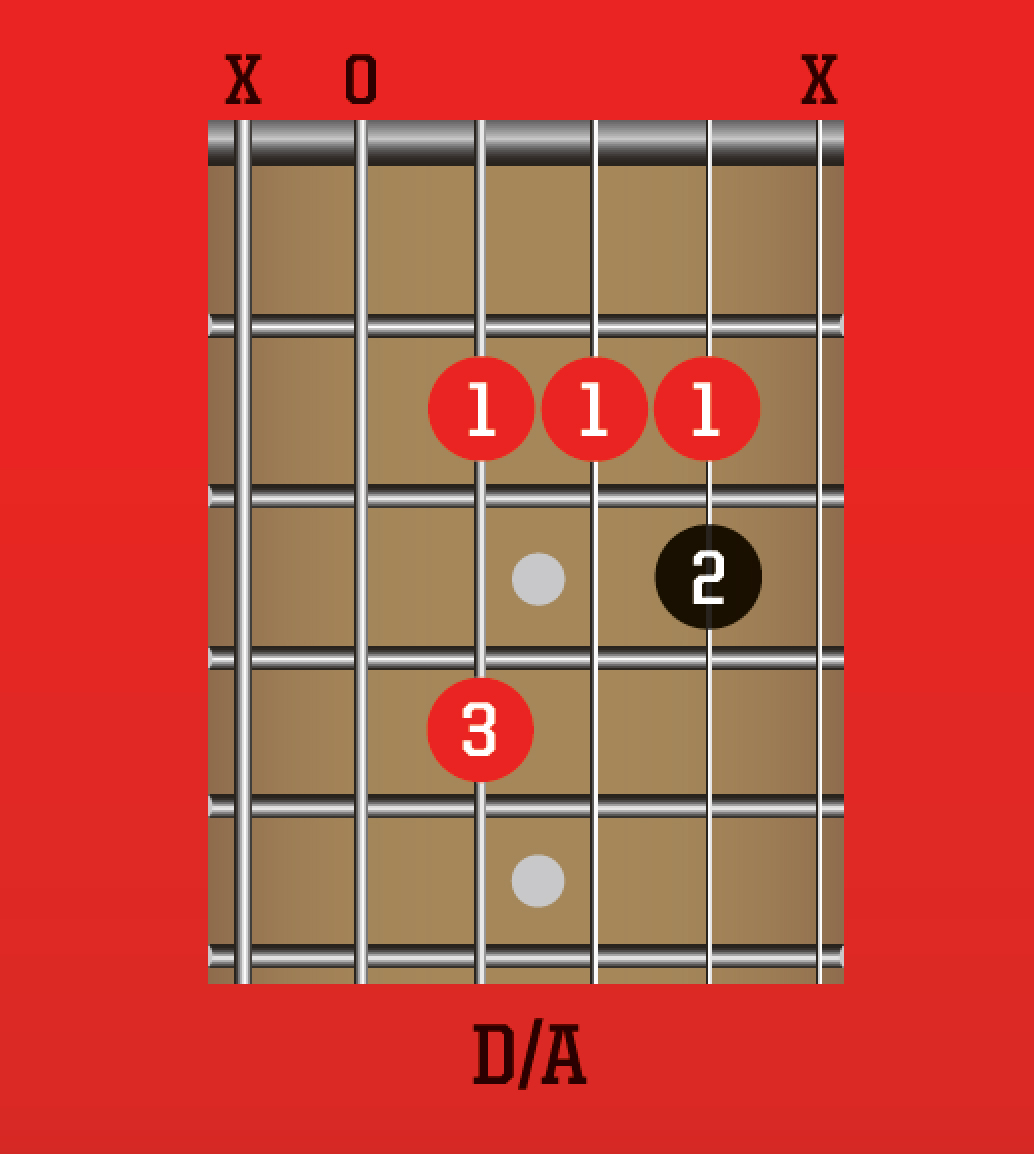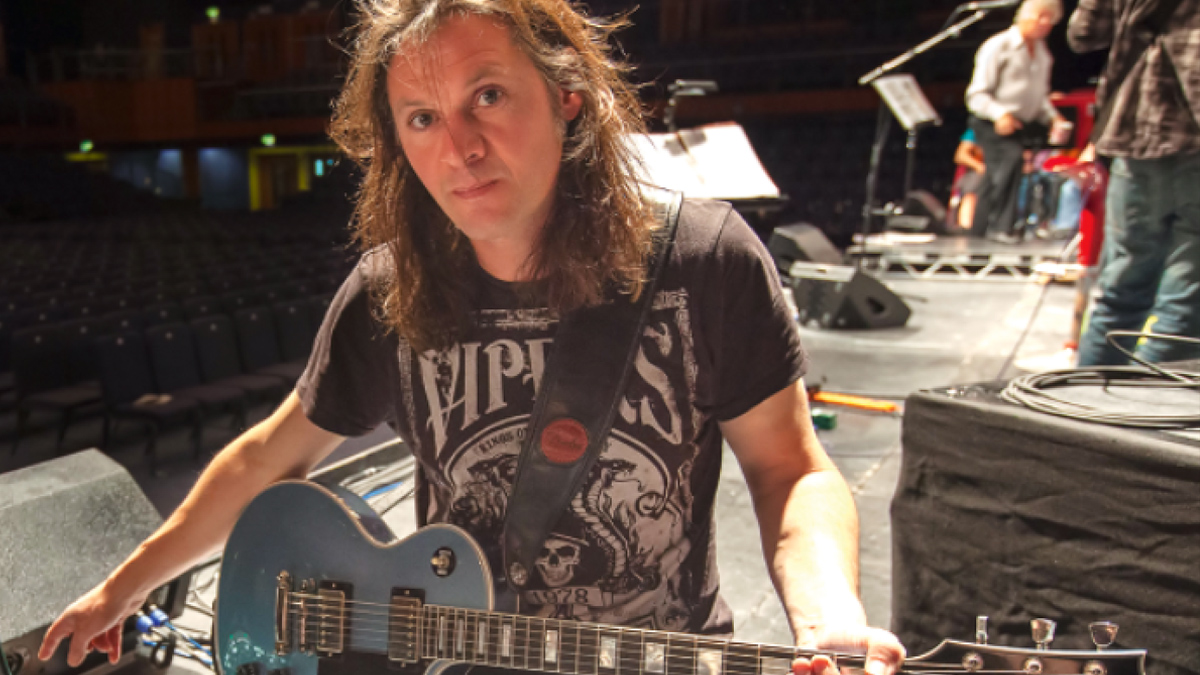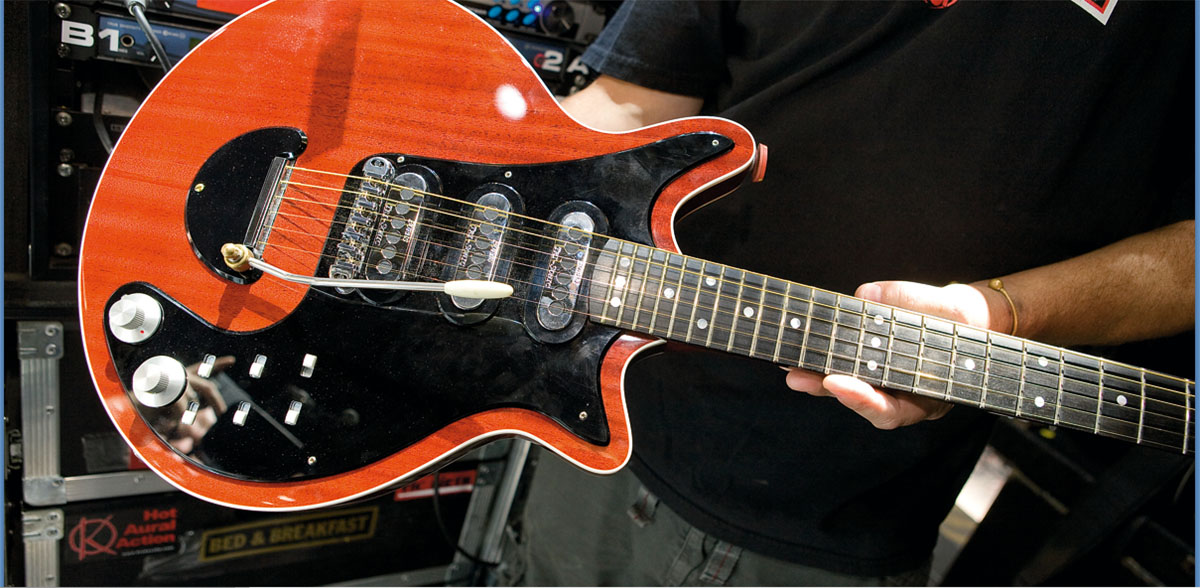How to play like Brian May
Our insider’s guide to emulating the unmistakable style of Queen’s legendary guitarist


A simple but effective chord: One of May's anchors is D/A, where he plays the notes of a D chord over the open A string. He's used it on countless occasions in both solo passages (We Will Rock You and A Kind Of Magic) and rhythm sections (Put Out The Fire and One Vision). Hammer To Fall, a true go-ahead rocker, is built upon D/A and it's a chord that's essential to nailing May s playing style.
Best example: Hammer To Fall (The Works, 1984) 0:00 0:07 and throughout
Since winning Total Guitar's prestigious Guitarist Of The Year competition back in 1994, Dave Colquhoun has toured and recorded with a number of diverse artists including Ian Brown, Bow Wow Wow, Francis Dunnery, Go West and even rock bastions Bananarama.
He’s also worked with Brian May, and it was through this relationship that Dave found himself on set of the recent Freddie Mercury biopic Bohemian Rhapsody.
There, he coached actors Gwilym Lee and Rami Malek, neither of whom were actually players of any note, to allow them to convincingly mimic May and Mercury’s guitar styles for the hugely successful film.
Dave is now guitarist with Rick Wakeman’s English Rock Ensemble and also finds time to teach at Croydon’s BRIT School for Performing Arts and Technology and the WaterBear Music College.
But we’ve managed to tear him away from all that to give us his insider tips on recreating May’s unique style.

Phrasing and feel
Practice makes perfect in this vital area
Brian May is a master of injecting his playing with feel and, in this regard at least, he’s up there with just about anyone who’s ever picked up the instrument. Phrasing and feel are fundamental facets of his style that, as Dave stresses, take technique and skill to accommodate.
Want all the hottest music and gear news, reviews, deals, features and more, direct to your inbox? Sign up here.
“I’d say that the most important thing to do is to switch the phrasing around,” says Dave. “If you take the Bohemian Rhapsody solo apart, you’ve got what I refer to as an ‘acceleration’ when it runs between 16ths and triplets and then back again (from 2:44-2:47). It makes you play the same pattern and you just change the note grouping of it.
“It’s actually a simple concept but can be tricky as you’re always looking for the downbeat, but just try repeating the pattern in 16ths and in triplets. It’s challenging to slow down to go out of a triplet back to a 16th note, but you just learn to phrase and you can bend and hang onto a note to give yourself time to think. I try to imagine it in my brain and somehow my hand makes that sound but, as ever, it’s all about effective practice.”
Best example: Love Of My Life (A Night At The Opera, 1975) 2:18-3:00
Soloing with melody
Always apply melody and space to solos
May’s solos are amongst rock’s finest and he’ll always construct them around a melody so they properly serve the song.
“An interesting thing with Queen recordings is that it’s almost as if the solo is a complementary piece within the song,” Dave points out. “If you look at Somebody To Love the guitar is given a lot of space and when it’s featured it becomes the focus of the attention. Then it pretty much disappears from the mix altogether, which means that when he’s given the moment to shine and it’s about the guitar, he knows he won’t get in the way of anything; he’s given space. Yes, it’s a solo but then it’s also like a separate piece of music within the full song.”
Best example: Somebody To Love (A Day At The Races, 1976) 2:01-2:22
Finger vibrato
A fundamental part of any player’s technique
May’s elegant vibrato is unmistakable and it’s a cornerstone of his playing that he adjusts to fit the differing styles, tempos and vibes of the songs and guitar lines with which he’s made his name. “The main thing is to be able to bend up to a note and vibrato just under the pitch you’ve bent to, then to drop down and back up again,” explains Dave. “Try not to ever let it go sharp either.
I think it’s really important to play standing up too as hand position is critical.
Dave Colquhoun on May's vibrato
“I think it’s really important to play standing up too as hand position is critical. So, my two tips would be to practise standing and also to tune into the tempo of the vibrato as it’d obviously need to be different for Hammer To Fall compared to, say, These Are The Days Of Our Lives.”
I think it’s really important to play standing up too as hand position is critical
Dave Colquhoun on May's vibrato
Best example: Killer Queen (Sheer Heart Attack, 1974) 1:40-2:00
Guitar vibrato
How to add vibrato to chords to aid the guitar’s musicality
If you watch May onstage you’ll notice that his right hand rarely strays from the guitar’s vibrato arm. He’ll often have his fingers and palm wrapped around it close to where it meets the bridge and will manipulate it to slightly move the tuning when playing chords; he considers this allows the guitar to bed in more musically with the rest of the band. A light touch is required and the technique is simple to recreate with versions of Fender’s Synchronized tremolo, a Bigsby or, if you’re careful, a double-locking system.
Best example: One Vision (Queen – Live At Wembley, 1986) 5:00-5:32
Picking dynamics
How the use of a coin as a pick can add texture and colour
Another intrinsic part of May’s tone is his use of an English sixpence as a pick. He likes the intimate connection that its inflexibility gives and he will either delicately stroke the strings to give a metallic character to the sound or minutely alter the angle of his hand to dig the coin’s serrated edge into the strings, resulting in a more aggressive and gnarly tone. There’s a great example of the latter technique at 0:42 during the song Death On Two Legs.
Sixpences aren’t too difficult to find online, but you can get an idea of the influence the coin can have by experimenting with a good old five pence piece even though it’s smaller and fatter than a sixer. If locating a stash of these old coins proves difficult, try using the more ubiquitous Aussie five cent coin or the slightly smaller and thinner American dime. Best example It’s Late (News Of The World, 1977) 0:00-0:15
Cleaning up
Every guitar has a volume control. Use it
When a clean tone is required, May will reach for the guitar’s volume knob. His amps are always run flat out and he’s never used any type of channel switching, so it’s down to him to manipulate the pot to quickly go from a full-throated overdrive to a lilting clean.
Do practise at some sort of volume if you can, although I’m sure the readers’ neighbours won’t love me for saying that!
Dave Colquhoun
“It’s just the way that it goes from distorted to totally clean and it sounds like he’s changed the amp,” says Dave. “The volume Brian plays at is pretty intimidating and just touching the guitar like he does, stroking the strings and coaxing sounds out of it, makes you realise how good he is at being so sensitive with it.
“Do practise at some sort of volume if you can,” says Dave, “although I’m sure the readers’ neighbours won’t love me for saying that!”
Best example: Spread Your Wings (Live Killers, 1979) 0:53-1:07
Bending
Practise bends to add some vital emotion
May uses light strings and a very low action so he needs to be in full control when bending up to a note. “If you’re practising bends you need to consider which string it is that you’re bending and where on that string you are,” Dave advises. “I’d suggest that the easiest place to practise and learn control is on the G, somewhere from the middle of the string length to about the 12th fret. Of course, as you get closer to the bridge or the nut the tension changes significantly so although you’re trying to reach the same pitch, you’re going to have to apply a different amount of pressure to get the same result depending on where you’re bending from.
“With the high E you need an awful lot of pressure so you’re trying to achieve the same sound across all strings wherever you are on the neck, which involves listening for the pitch and then applying the correct pressure to get there.
“Play over a drone of whatever note you’re choosing and then try to get the pitch exactly the same as you bend up from different parts of the string. You’re trying to make a musical dissonance between where you’re bending from and how long it takes that bend to get up to the note. Another great way to practise is to bend to the note as a pre-bend and then listen to where your pitch is when you get to it: that’ll teach you about the pressure needed.”
Best example: We Are The Champions (News Of The World, 1977) 2:40-2:58
Use your index finger
A signature pick-hand technique to add expression
When May needs a softer sound he’ll sometimes palm the sixpence and use his index finger to entice notes from the string. It’s a subtle yet very effective way of adding dynamics and expression for heartbreaking emotion.
“I did actually ask Brian about this,” Dave clarifies. “And he explained that it’s to get direct contact with the string. He was trying to say that he was picking along the length of the string, so it’s almost like he was stroking it. What I took from that was that when you normally pick a note it will initially go sharp as it’s vibrating until it starts to settle again, but if you pick it more gently and along the length of the string it will stay at pitch. So if you pick it really gently you’re almost fine-tuning and it’ll be very sweet-sounding.”
Best example: Bohemian Rhapsody (A Night At The Opera, 1975) 5:33-end
Know your legato
A well-used part of the tonal arsenal
Legato is an essential technique for smooth and swift lead work and Brian has often used a mixture of it combined with alternate picking in his playing, not to mention a slick hybrid of tapping and string bending.
“Brian is predominantly a legato player so any hammering-on needs to be smooth,” explains Dave. “Use the weight of your hand rather than thinking of it as being just your finger that’s hitting the string. Use it for a musical reason, and think about where the accent is within the beat too. I’ll play the same patterns and I’ll be looking for where the offbeat is or where the downbeat is. Then the battle is to make the hammered-on notes as loud as the picked notes, so you’ve got to up the intensity of the hammer-on then lower the volume of the picked notes. Again, it’s control.”
Best example: It’s Late (News Of The World, 1977) 3:33-3:49

Taming feedback
How to make your feedback sound musical
The semi-acoustic construction and colossal neck of May’s iconic Red Special guitar, not to mention the sheer volume at which the amps are run, means that he has a surprisingly musical feedback virtually on tap.
“It’s about proximity but it’s not easy at domestic volumes,” Dave confirms. “As a place to start, if you point the guitar at the amp there’ll be a spot where it takes off somewhere, but you’ve got to walk around the room until you get it to feedback. It’s so much a part of Brian’s sound but it’s not a distortion sustain; it’s more like a feedback that’s always there. With Brian’s style it’s more about stopping the feedback than trying to get it when you want it.”
Best example: We Will Rock You (News Of The World, 1977) 1:21-1:32
Finding harmony
Wonderful harmonies are a Queen signature
Bohemian Rhapsody is the perfect illustration of how Queen skilfully multi-tracked vocals to stunning effect and May applied many of the same recording techniques for his unique and staggeringly inventive guitar orchestrations. Our advice in tackling the daunting task of recreating such musical confections would be to consider the full chords that underpin the core melody you’ve come up with, and then to experiment with inversions and finger positions to identify effective harmonies.
Build the chords with one note per track and try to ensure that the harmonies entwine rather than simply follow each other up and down in step. Be warned: it’s a highly technical and laborious process that’ll make you wonder how on earth Queen managed to do any of it in the pre-digital era!
Best example: All Dead, All Dead (News Of The World, 1977) 1:42-2:13
Tie your wallet down
Getting May’s sound on a budget… and beyond
The unavoidable truth is that authentically obtaining the Brian May sound is difficult without some specific gear, and a Strat into an overdriving Marshall will only get you on the lower rungs of the ladder in this scenario.
Consider opting for a guitar whose design is based on that of the Red Special simply because it can do things that the majority of other production guitars don't, such as providing pickups that are wired in series: the BMG Special (£695) is the ideal option. You'll need some sort of treble booster or specifically voiced overdrive, too, and we can certainly recommend the impressively authentic Catalinbread Galileo (£129), a stompbox that just about merits its Brian May-in-a-box reputation. The Vox Pathfinder 10 (around £64) or Marshall's MG15R (£95) are both decent options, especially for home use, and a BOSS CH-1 chorus (£75) will infuse the tone with a shimmering richness.

If you are already the owner of a guitar loaded with a mid-powered or vintage-voiced bridge humbucker, you can try the combination of a Vox AC30S1 (around £555) and BMG/KAT's innovative Treble Booster Classic (£249).
The latter provides a trio of distinct settings based on the idiosyncrasies of the particular boosters May used during three specific decades, while the amp, boasting one channel and a single Celestion speaker, gives just the right level of tube dynamics thanks to its EL84 driven power section.
Set the EQ flat, dial in the amount of gain that best suits your guitar, and whack the volume all the way up: it ll be crushingly loud but will be more than worth it. If money is no object, the spectacular BMG Super (£2,950) is about as close in spec and playability to May's original guitar as a production model is likely to get.
Then just back it up with three modified Vox AC30C2 combos (£various) a pair of TC Electronic G Major 2 rack units (£499 each), a KAT STB booster (£222), some custom wizardry from electronics gurus Nigel Knight and Mike Hill, and a stadium full of fans. Simples...
Simon Bradley is a guitar and especially rock guitar expert who worked for Guitarist magazine and has in the past contributed to world-leading music and guitar titles like MusicRadar (obviously), Guitarist, Guitar World and Louder. What he doesn't know about Brian May's playing and, especially, the Red Special, isn't worth knowing.

